Research on Design Strategy of Mask Recycling Service Based on Behavior Environment
Abstract
1. Introduction
2. Materials and Methods
3. Results
3.1. Mask Recycling Visual Communication Design
3.2. Mask Recovering Device Design
3.3. Mask Recycling Service Strategy Design
- (1)
- Stakeholder benefit analysis
- (2)
- User experience journey map construction.
- (3)
- Service process design
4. Discussion
5. Conclusions
Author Contributions
Funding
Institutional Review Board Statement
Informed Consent Statement
Data Availability Statement
Conflicts of Interest
References
- Xu, R.; Disposable masks have environmental Costs. Chin. J. Sci. 2021. Available online: https://news.sciencenet.cn/sbhtmlnews/2021/7/364094.shtm (accessed on 13 June 2022).
- Amuah, E.E.Y.; Agyemang, E.P.; Dankwa, P.; Fei-Baffoe, B.; Kazapoe, R.W.; Douti, N.B. Are used face masks handled as infectious waste? Novel pollution driven by the COVID-19 pandemic. Resour. Conserv. Recycl. Adv. 2022, 13, 200062. [Google Scholar] [CrossRef] [PubMed]
- Shrotriya, A.; Tiwari, P.K.; Jain, T.; Gupta, R.; Sinha, A. Face Mask Waste Generation and Its Management during COVID-19. In Next Generation of Internet of Things, Proceedings of the ICNGIoT 2022, Odisha, India, 3–4 February 2022; Springer Nature: Singapore, 2022; pp. 481–488. [Google Scholar] [CrossRef]
- Chen, H.; Dong, X.; Zhao, Y.; Wang, D. Recycling and Chemical Upcycling of Waste Disposable Medical Masks. Acta Polym. Sin. 2020, 51, 1295–1306. [Google Scholar]
- Karmilasari, V.; Putri, D.S.; Faedlulloh, D.; Koswara, R. The Danger of Environmental Damage from Disposable Mask Waste During the COVID 19 Pandemic: Study of Student Habits in Using a Mask and Alternative Solution. In Proceedings of the 2nd International Indonesia Conference on Interdisci-plinary Studies (IICIS 2021), Batusangkar, Indonesia, 11–12 October 2021; pp. 272–278. [Google Scholar] [CrossRef]
- Erjavec, A.; Plohl, O.; Zemljič, L.F.; Valh, J.V. Significant Fragmentation of Disposable Surgical Masks—Enormous Source for Problematic Micro/Nanoplastics Pollution in the Environment. Sustainability 2022, 14, 12625. [Google Scholar] [CrossRef]
- Rathinamoorthy, R.; Balasaraswathi, S.R. Impact of coronavirus pandemic litters on microfiber pollution—Effect of personal protective equipment and disposable face masks. Int. J. Environ. Sci. Technol. 2022, 20–21. [Google Scholar] [CrossRef]
- Bussan, D.D.; Snaychuk, L.; Bartzas, G.; Douvris, C. Quantification of trace elements in surgical and KN95 face masks widely used during the SARS-COVID-19 pandemic. Sci. Total Environ. 2021, 814, 151924. [Google Scholar] [CrossRef] [PubMed]
- Ma, M.; Xu, D.; Zhao, J.; Gao, B. Disposable face masks release micro particles to the aqueous environment after simulating sunlight aging: Microplastics or non-microplastics? J. Hazard. Mater. 2023, 443, 130146. [Google Scholar] [CrossRef]
- Zhu, Y.; Cao, M.; Luo, J.; Zhang, Q.; Cao, J. Distribution and Potential Risks of Microplastics in China: A Review. Res. Environ. Sci. 2019, 32, 1437–1447. [Google Scholar] [CrossRef]
- Yuan, W.; Zhou, Y.; Chen, Y.; Liu, X.; Wang, J. Toxicological effects of microplastics and heavy metals on the Daphnia magna. Sci. Total Environ. 2020, 746, 141254. [Google Scholar] [CrossRef]
- Pourebrahimi, S. Upcycling face mask wastes generated during COVID-19 into value-added engineering materials: A review. Sci. Total Environ. 2022, 851, 158396. [Google Scholar] [CrossRef]
- Sazdovski, I.; Bala, A.; Fullana-I-Palmer, P. Linking LCA literature with circular economy value creation: A review on beverage packaging. Sci. Total Environ. 2021, 771, 145322. [Google Scholar] [CrossRef]
- Mager, B.; de Leon, N. Service Design: Innovation for Complex Systems. In The Palgrave Handbook of Service Management; Springer International Publishing: Berlin/Heidelberg, Germany, 2022; pp. 483–496. [Google Scholar] [CrossRef]
- Luo, S.; Hu, Y. Model Innovation Driven by Service Design. Packag. Eng. 2015, 36, 1–4+28. [Google Scholar] [CrossRef]
- Nannan, L.; Zhangping, L.; Mingzhu, L.; Ying, D. Digital experience design of qinhuai lantern based on user journey map. E3S Web Conf. 2021, 236, 05080. [Google Scholar] [CrossRef]
- Gifford, R. Environmental Psychology Matters. Annu. Rev. Psychol. 2014, 65, 541–579. [Google Scholar] [CrossRef] [PubMed]
- Lin, J.; Xiong, Y.; Song, J.; Ji, X. Spatial Conservation and Development of Dong Ethnic Settlements under Environment Behavior Studies. J. Sociol. Ethnol. 2022, 4, 124–130. [Google Scholar] [CrossRef]
- Rodriguez, L.; Peralta, C. From Product to Service Design: A Thinking Paradigm Shift. FormAkademisk 2014, 7, 3. [Google Scholar] [CrossRef]
- Liang, Y.; He, S.; Zhan, B. Multiple Values of Service Design in Participating in Social Sustainability: Research on Food Design in Zhenze, Suzhou, China. In With Design: Reinventing Design Modes, Proceedings of the 9th Congress of the International Association of Societies of Design Research (IASDR 2021); Hong Kong, China, 5–9 December 2021, Springer Nature: Singapore, 2022; pp. 2393–2413. [Google Scholar] [CrossRef]
- Luca, E.J.; Ulyannikova, Y. Towards a User-Centred Systematic Review Service: The Transformative Power of Service Design Thinking. J. Aust. Libr. Inf. Assoc. 2020, 69, 357–374. [Google Scholar] [CrossRef]
- Lewin, K. Principles of Topological Psychology; China Media University Press: Beijing, China, 2018; ISBN 978-7-5657-2126-70. [Google Scholar] [CrossRef]
- Hu, Z.; Lin, Y. Environmental Psychology: Environment-Behavior Research and Its Design and Application; China Architecture and Building Press: Beijing, China, 2018; ISBN 7-112-22146-2. [Google Scholar]
- Zhang, Y.; You, B.; Shi, S.; Lu, Y.; Rao, L.; Zhang, M. Research on Safety Psychology Methodology. China Saf. Sci. J. 2021, 31, 181–188. [Google Scholar] [CrossRef]
- Sun, C.X.; Bin, H.E.; Di, M.U.; Li, P.L.; Zhao, H.T.; Li, Z.L.; Zhang, M.L.; Feng, L.Z.; Zheng, J.D.; Li, Z.J. Public Awareness and Mask Usage during the COVID-19 Epidemic: A Survey by China CDC New Media. Biomed. Environ. Sci. 2020, 33, 639–645. [Google Scholar] [CrossRef]
- He, W.; Cai, D.; Geng, G.; Klug, D. Factors influencing wearing face mask in public during COVID-19 outbreak: A qualitative study. Disaster Med. Public Health Prep. 2022, 1–7. [Google Scholar] [CrossRef]
- Wang, C. Research on Product Bionic Modeling Design Based on Lattice Topology Model; Xiangtan University: Xiangtan, China, 2020. [Google Scholar]
- Xia, F.; Huang, S. Application Research of Color Design and Collocation in Image Processing. Comput. Syst. Sci. Eng. 2020, 35, 91–98. [Google Scholar] [CrossRef]
- Jiang, Q.; Leeabai, N.; Dilixiati, D.; Takahashi, F. Perceptive preference toward recycling bin designs: Influential design item depending on waste type, the impact of past perception experiences on design preference, and the effect of color design on waste separation. Waste Manag. 2021, 127, 130–140. [Google Scholar] [CrossRef] [PubMed]
- Prabhir, M. Ergonomics Principles in Design: An Illustrated Fundamental Approach; CRC Press: Boca Raton, FL, USA, 2022; ISBN 9781003302933;1000645800;9781000645804. [Google Scholar]
- Melles, G.B. Designing Social Innovation for Sustainable Livelihoods. In Designing Social Innovation for Sustainable Livelihoods; Springer Nature: Singapore, 2022; pp. 1–11. [Google Scholar] [CrossRef]
- Rosenbaum, M.S.; Otalora, M.L.; Ramírez, G.C. How to create a realistic customer journey map. Bus. Horizons 2017, 60, 143–150. [Google Scholar] [CrossRef]
- Marzouk, M.; Elshaboury, N.; Azab, S.; Megahed, A.; Metawie, M. Assessment of COVID-19 impact on sustainable development goals indicators in Egypt using fuzzy analytic hierarchy process. Int. J. Disaster Risk Reduct. 2022, 82, 103319. [Google Scholar] [CrossRef] [PubMed]
- Song, S.; Che, J.; Yuan, X. Disaster Prevention and Mitigation Index Assessment of Green Buildings Based on the Fuzzy Analytic Hierarchy Process. Sustainability 2022, 14, 12284. [Google Scholar] [CrossRef]
- Wang, G.; Dang, P.; Li, Y. Research on the evaluation system of new energy development decision in Dunhuang city based on analytic hierarchy process. Energy Rep. 2022, 8, 129–135. [Google Scholar] [CrossRef]
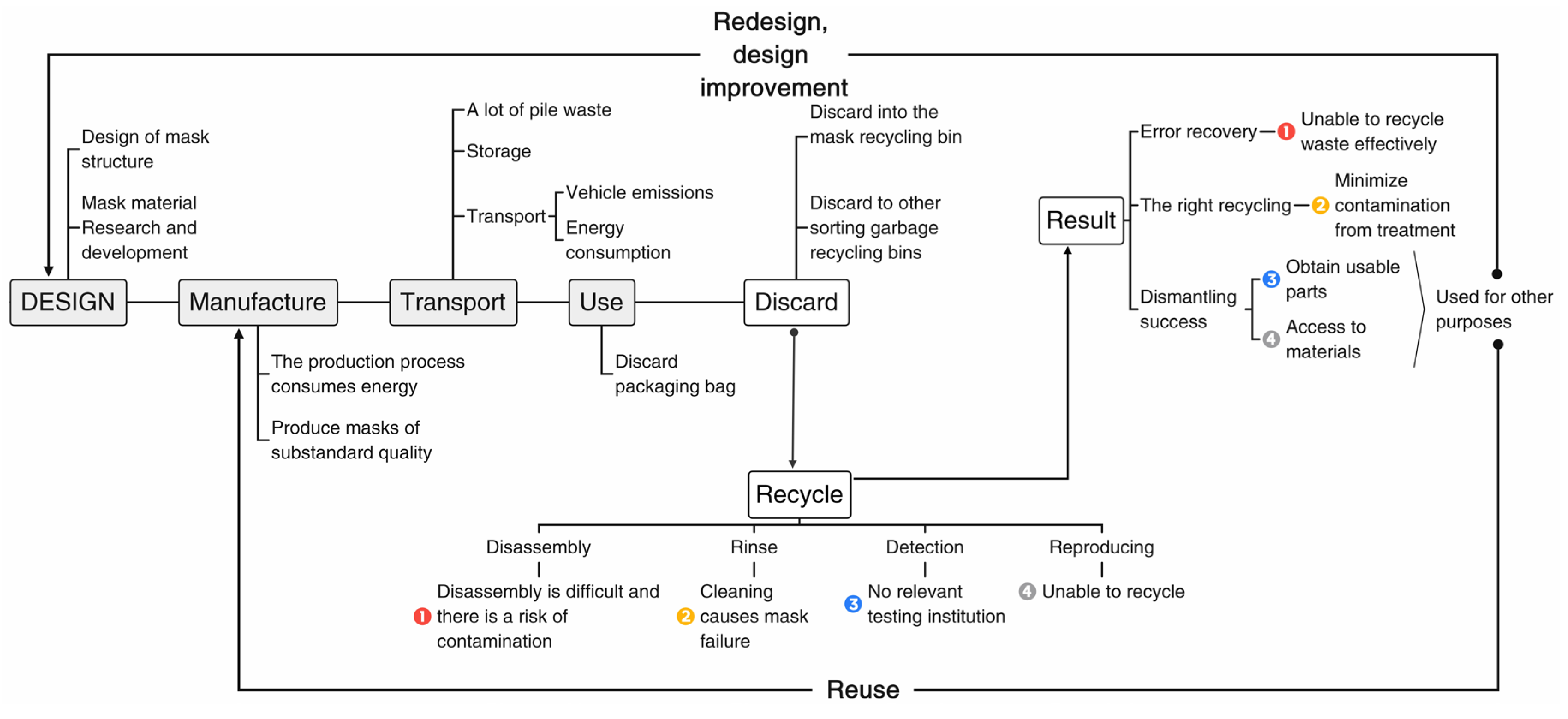
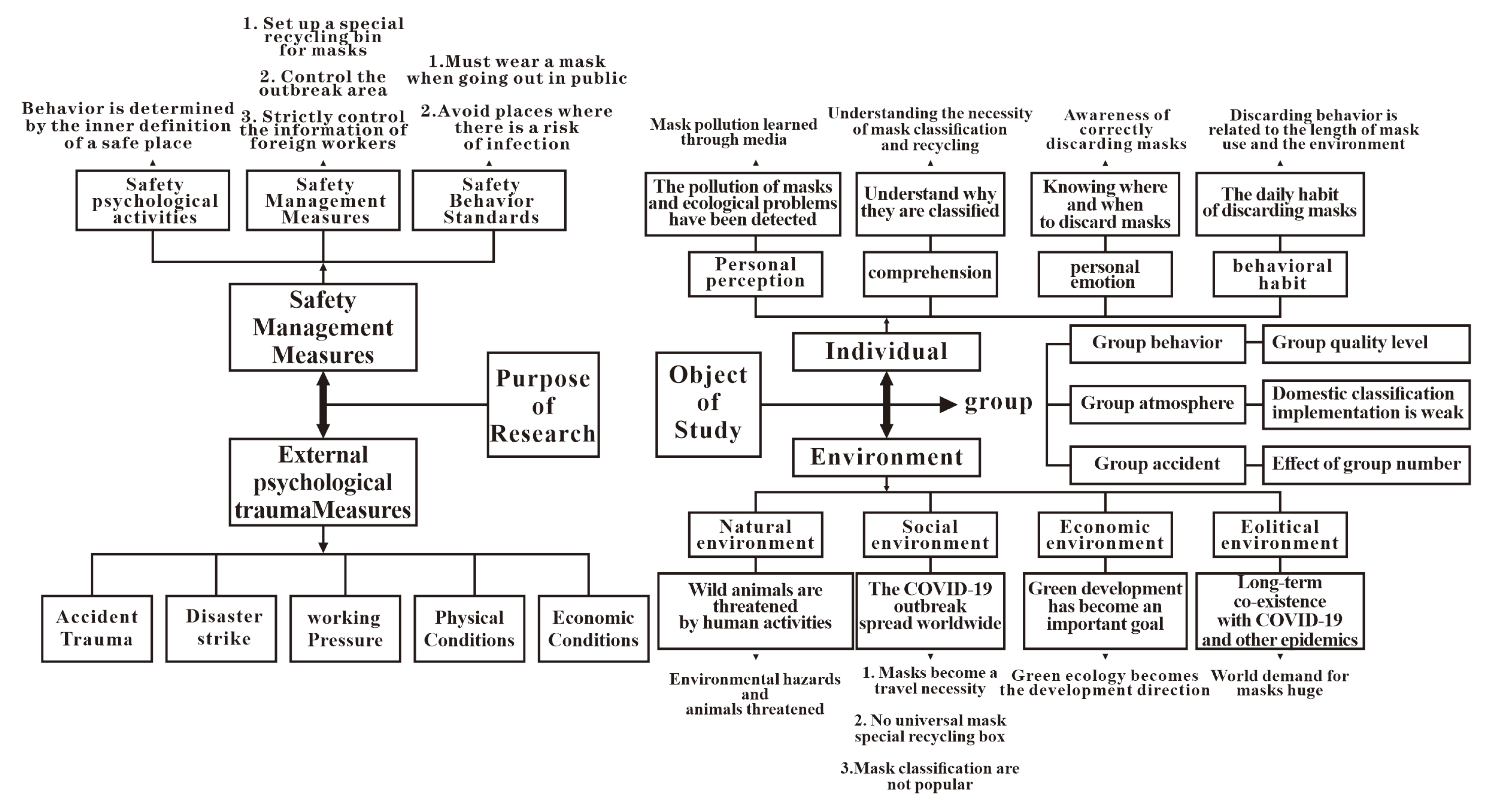

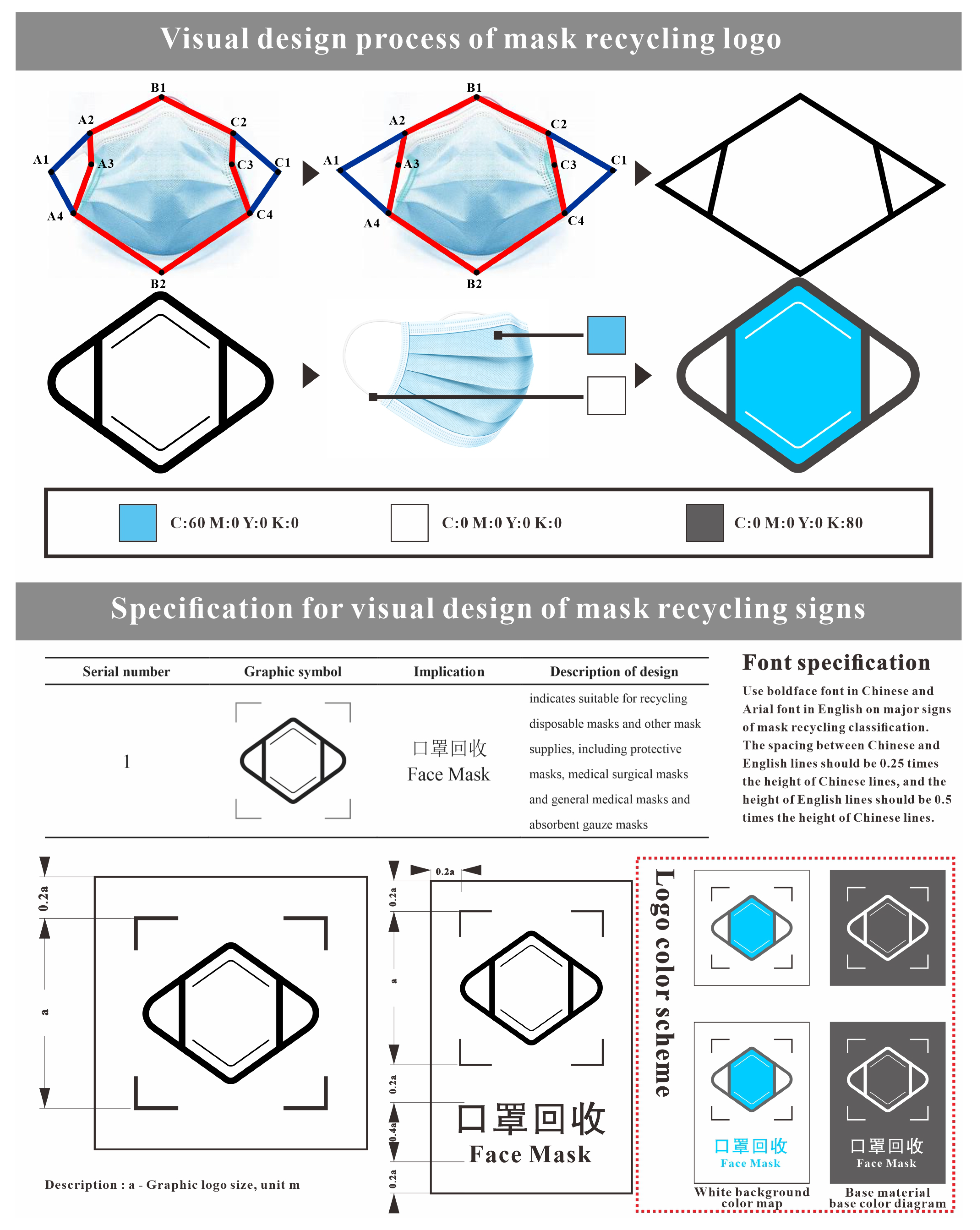
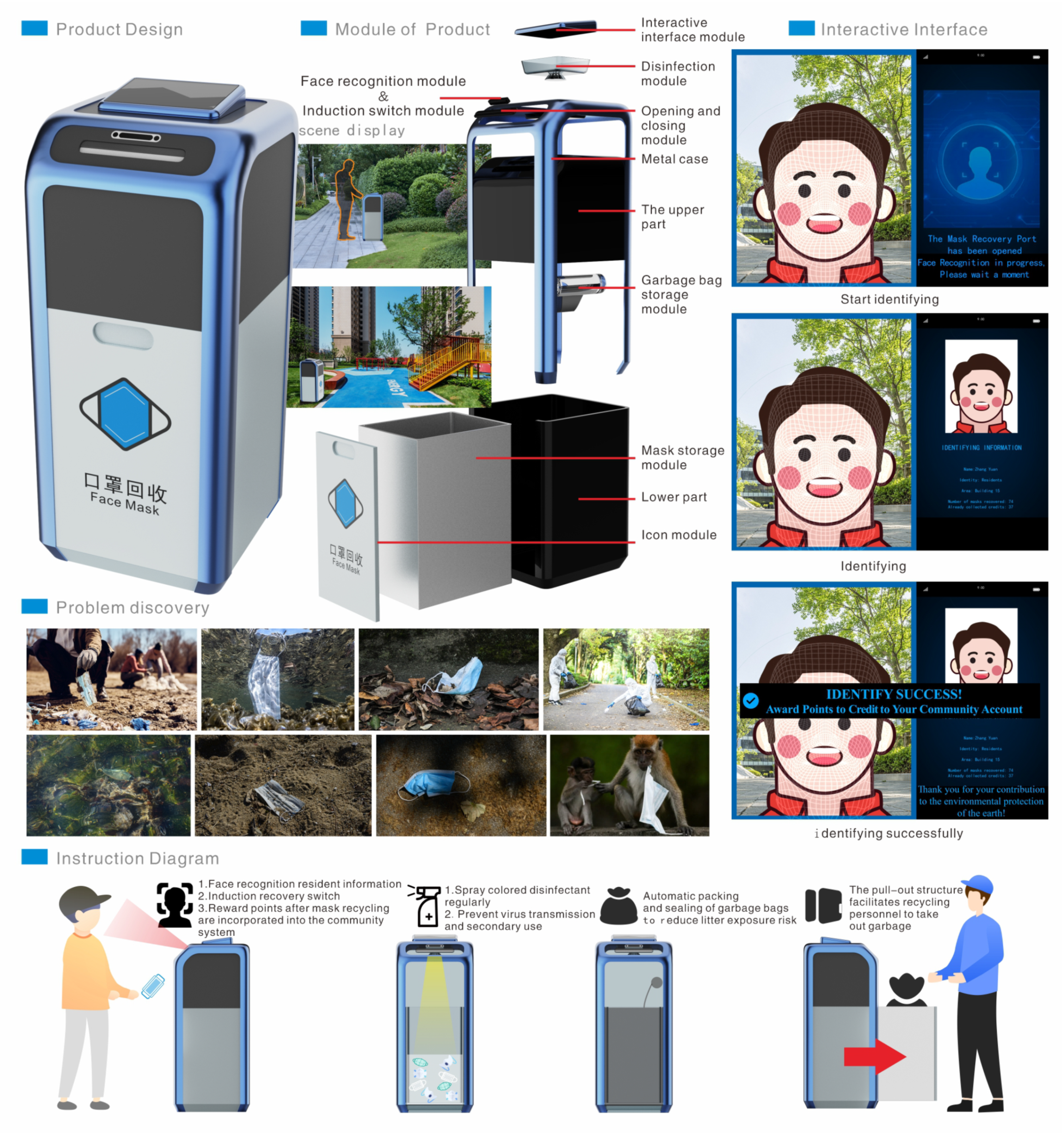
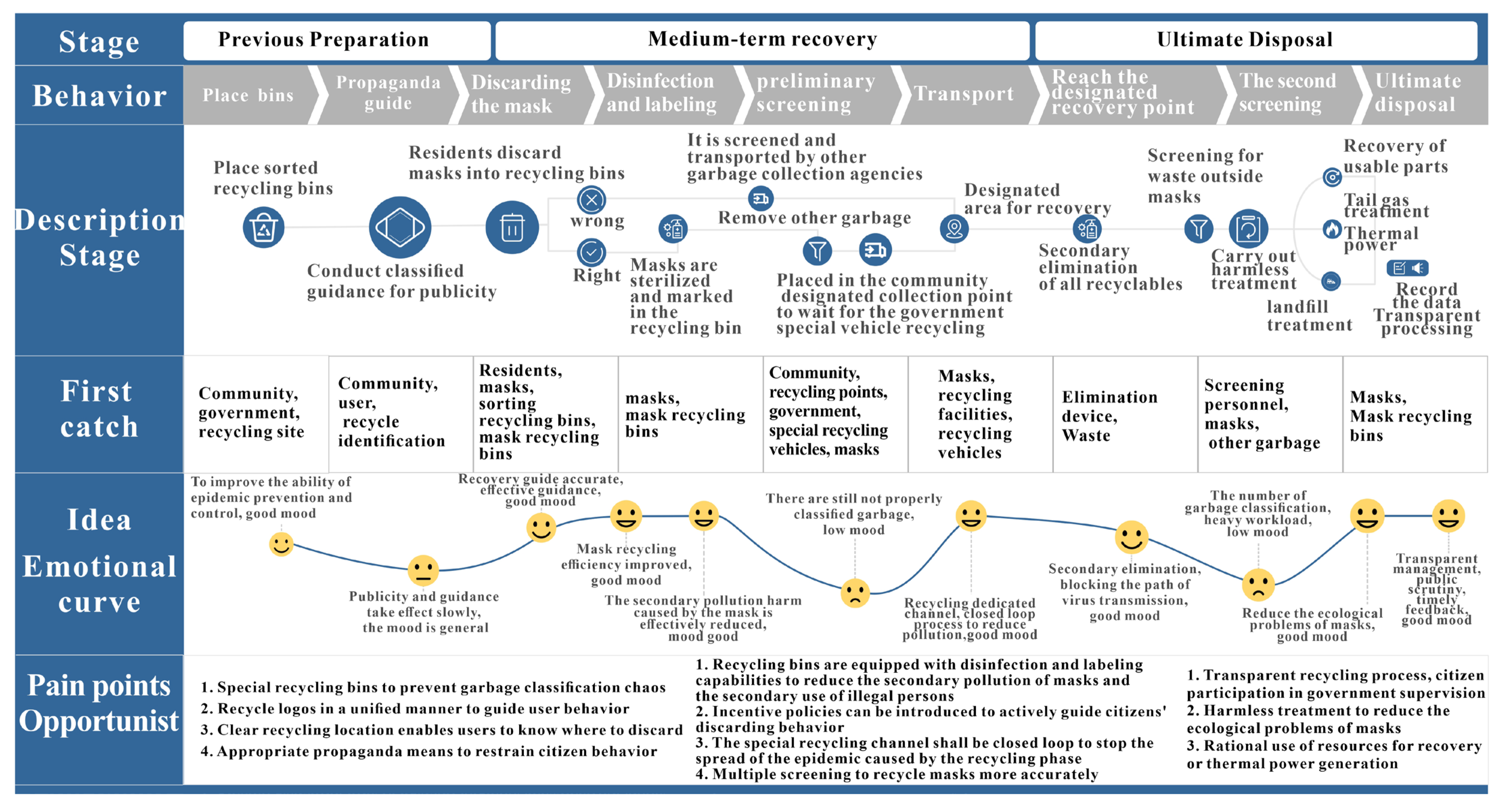

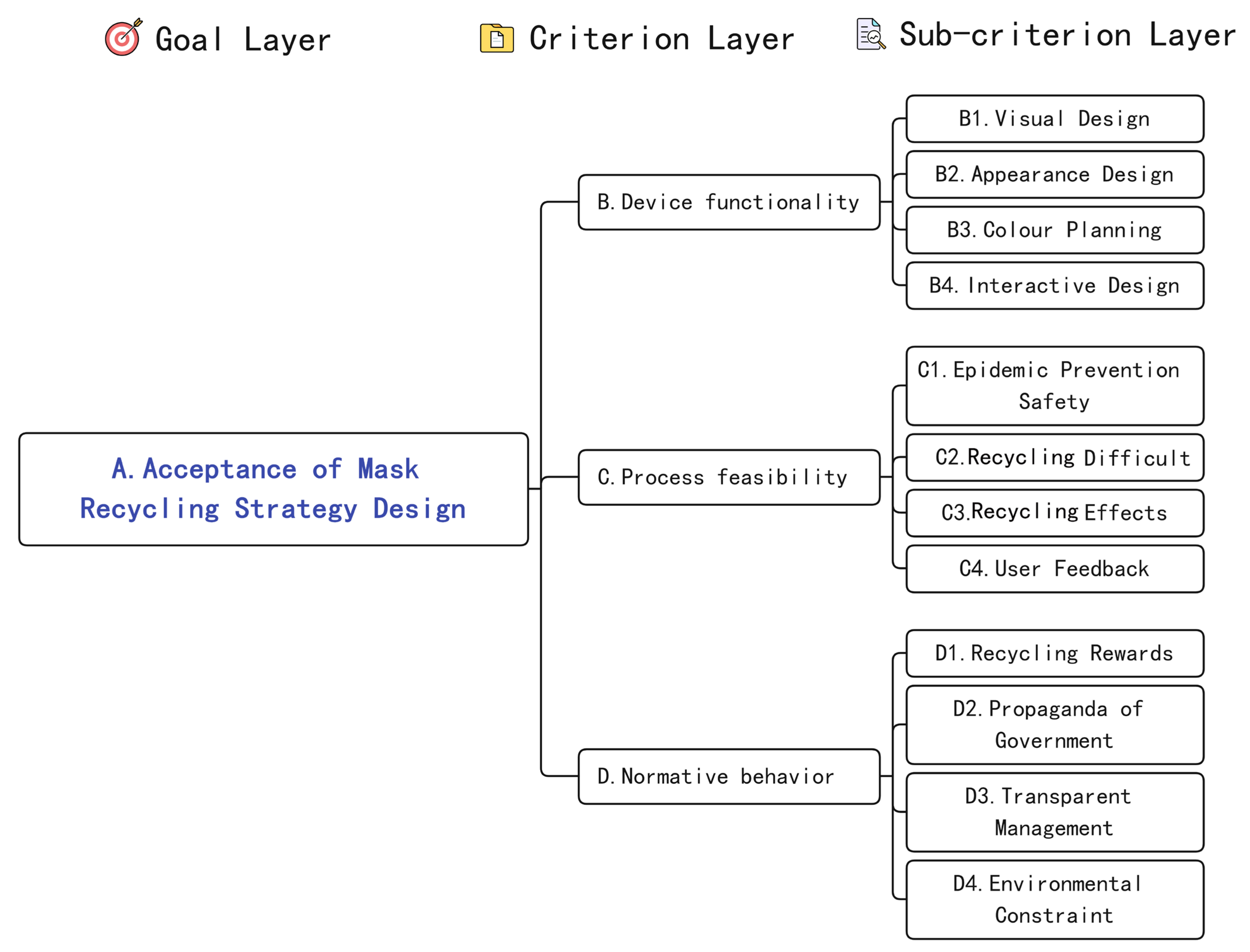
| Mask Recycling Device | Recycling Box Category | Color | Visual Identification and Poster Content | Contact Structure | Space Site | Recycling Efficiency | Score |
|---|---|---|---|---|---|---|---|
 | Health Care Waste |  |  Recycling box for masks | Portable | Food Business Street | In full condition, more than 90% is food waste | 1 |
 | Health Care Waste |  |  Recycling box for masks | Pedal | Campus Street | Less garbage, a small amount of household garbage, mask packaging and masks | 2 |
 | Health Care Waste |  | Marker-less | Pedal | Work Area | Less garbage, internal garbage is mostly mask bags | 2 |
 | Harmful Refuse |  |  Recycling box for masks | Portable | Residents Downstairs | Less garbage, more than 90% masks | 4 |
 | Other Garbage |  |  Recycling box for masks | Pedal | Bus Station | More garbage, basically no masks | 1 |
 | Health Care Waste |  |  Recycling box for masks | Push cover | Community Doorway | Less garbage, masks, and garbage equivalent | 3 |
 | Other Garbage |  |  Mask recycling slogan | Portable | Commercial Block | More garbage, mostly domestic garbage inside, no masks | 1 |
 | Combined Type |   |  Recycling box for masks | Pedal | Drugstore Entrance | Basically no garbage inside, basically no masks | 3 |
| Behavioral Touch Points | Psychological Perception of the Location | Reality Perception of the Location | The Psychological Intention |
|---|---|---|---|
| Keep wearing | Have to wear | Required to wear or Not required | 1. Response to policy requirements to keep wearing. 2. Required that must be worn in the place. 3. Consider the environment hazardous and want to protect oneself. 4. Wear in the last environment or wear in the next environment. |
| Remove the mask (Not discarded) | No need to wear or Choose to wear according to the situation | Not required or Required to wear according to the situation | 1. No provision for wearing. 2. Think that the environment does not need masks to be worn. 3. Considers there is still a need for mask wearing. |
| Replace the mask | No need to wear or Choose to wear according to the situation | Not required or Required to wear according to the situation | 1. Wear according to conditions. 2. Failure or breakage of the mask, etc., considered dangerous. 3. Have spare masks and still need to wear them. |
| Discard masks | No need to wear | Not required or Required to wear according to the situation | 1. Mask not required. 2. Need for mask disposal. 3. Consider the need for subsequent maskless wearing. 4. Have one or more masks and do not know if they are effective. |
| Stakeholders | Behavior | Benefit | User Touch Points |
|---|---|---|---|
| Resident users | 1. Discard the mask. 2. Classify garbage preliminarily. 3. Submit the corresponding management fee. | 1. Constrains user behaviors 2. Reduce the labor costs. | Masks, garbage bags, trash cans, community managers, billboards, information platforms |
| Community Management Bodies | 1. Manage mask recycling bins. 2. Charge an administrative fee. 3. Provide corresponding maintenance services. 4. Screen classified garbage. 5. Publicize and manage the residents in the jurisdiction. 6. Transport sorted garbage. 7. Purchase public facilities. | 1. Improve the efficiency of management services and user satisfaction. 2. Respond to the government’s call and safeguard national interests. 3. Decrease ecological issues and reduce the spread of the epidemic. 4. Charge a management fee. | Government departments, mask recycling bins, transportation channels, resident management |
| The Government Manages The Recycling Department | 1. Provide disposable mask recycling standards and design standards. 2. Provide standardized disposable mask recycling devices. 3. Manage disposable mask recycling device. 4. Manage community properties, etc. 5. Popularize and publicize to citizens, etc. 6. Make improvements to mask recycling. | 1. Simplify the service process 2. Strengthen the cooperation among management departments. 3. Increase the cash flow. 4. Solve epidemic and environmental problems. 5. Optimize social governance methods. | Information platform, social management platform, national government affairs platform, local or national standards |
| Mask Recycling Device | 1. Impose constraints on user behavior. 2. Block other garbage. 3. Recycle masks. 4. Provide data feedback. | 1. Simplify the classification process. 2. Restrict user behavior. 3. Increase social benefits. 4. Make information feedback effective. | Recycling masks, guiding behavior, data collection |
| Other Garbage Recycling Plants | 1. Screen for mask waste. 2. Mask waste is sent to a dedicated mask recycling facility through a dedicated channel | 1. Protect ecological environment. 2. Increase recyclable efficiency. 3. Reduce recyclable waste. | Mask sorting, mask dis-carding, other trash bins, communities |
| Quantified Standard | Matrix Assignment |
|---|---|
| Event i is as important as event j | 1 |
| Event i is slightly more important than event j | 3 |
| Event i is significantly more important than event j | 5 |
| Event i is more important than event j | 7 |
| Event i is extremely important compared to event j | 9 |
| Event i is slightly less important than event j | 1/3 |
| Event i is significantly less important than event j | 1/5 |
| Event i is less important than event j | 1/7 |
| Event i is extremely less important than event j | 1/9 |
| Z | B | C | D | Weight W | Maximum | CI |
|---|---|---|---|---|---|---|
| B | 1 | 1/5 | 1/4 | 0.10179 | 3.095 | 0.047 |
| C | 5 | 1 | 1/2 | 0.36607 | ||
| D | 4 | 2 | 1 | 0.53214 |
| Z1 | B1 | B2 | B3 | B4 | Weight WB | Maximum | CI |
|---|---|---|---|---|---|---|---|
| B1 | 1 | 1/3 | 1/2 | 1/5 | 0.08027 | 4.260 | 0.087 |
| B2 | 3 | 1 | 1/2 | 1/5 | 0.14572 | ||
| B3 | 2 | 2 | 1 | 1/6 | 0.16330 | ||
| B4 | 5 | 5 | 6 | 1 | 0.61071 |
| Z2 | C1 | C2 | C3 | C4 | Weight WC | Maximum | CI |
|---|---|---|---|---|---|---|---|
| C1 | 1 | 1 | 1 | 1 | 0.23786 | 4.216 | 0.072 |
| C2 | 1 | 1 | 1/2 | 1/2 | 0.17101 | ||
| C3 | 1 | 2 | 1 | 1/3 | 0.22070 | ||
| C4 | 1 | 2 | 3 | 1 | 0.37043 |
| Z3 | D1 | D2 | D3 | D4 | Weight WD | Maximum | CI |
|---|---|---|---|---|---|---|---|
| D1 | 1 | 1/3 | 1/2 | 1/4 | 0.09577 | 4.162 | 0.0544 |
| D2 | 3 | 1 | 1/2 | 1/3 | 0.18295 | ||
| D3 | 2 | 2 | 1 | 1/3 | 0.22243 | ||
| D4 | 4 | 3 | 3 | 1 | 0.49886 |
| Z | Z1 | Z2 | Z3 | |
|---|---|---|---|---|
| λmax | 3.095 | 4.260 | 4.216 | 4.162 |
| CI | 0.047 | 0.087 | 0.072 | 0.054 |
| RI | 0.520 | 0.890 | 0.890 | 0.890 |
| CR | 0.091 | 0.097 | 0.081 | 0.061 |
| First-Level Indicators | Secondary Indicators | Very Effective | Effective | Neutral | Invalid | Very Ineffective |
|---|---|---|---|---|---|---|
| B | B1 | 0.4052 | 0.3966 | 0.1638 | 0.0345 | 0 |
| B2 | 0.3793 | 0.3793 | 0.2155 | 0.0259 | 0 | |
| B3 | 0.3966 | 0.3534 | 0.1983 | 0.0517 | 0 | |
| B4 | 0.3879 | 0.3879 | 0.1897 | 0.0345 | 0 | |
| C | C1 | 0.4138 | 0.3879 | 0.1552 | 0.0345 | 0.0086 |
| C2 | 0.3793 | 0.4052 | 0.1638 | 0.0431 | 0.0086 | |
| C3 | 0.3448 | 0.431 | 0.1983 | 0.0086 | 0.0172 | |
| C4 | 0.3276 | 0.3362 | 0.2845 | 0.0431 | 0.0086 | |
| D | D1 | 0.4224 | 0.4138 | 0.1207 | 0.0345 | 0.0086 |
| D2 | 0.4052 | 0.4052 | 0.1466 | 0.0345 | 0.0086 | |
| D3 | 0.4138 | 0.4052 | 0.1552 | 0.0172 | 0.0086 | |
| D4 | 0.4138 | 0.4138 | 0.1466 | 0.0086 | 0.0172 |
Disclaimer/Publisher’s Note: The statements, opinions and data contained in all publications are solely those of the individual author(s) and contributor(s) and not of MDPI and/or the editor(s). MDPI and/or the editor(s) disclaim responsibility for any injury to people or property resulting from any ideas, methods, instructions or products referred to in the content. |
© 2023 by the authors. Licensee MDPI, Basel, Switzerland. This article is an open access article distributed under the terms and conditions of the Creative Commons Attribution (CC BY) license (https://creativecommons.org/licenses/by/4.0/).
Share and Cite
Wu, Y.; Zhang, H.; Zhang, M. Research on Design Strategy of Mask Recycling Service Based on Behavior Environment. Sustainability 2023, 15, 1065. https://doi.org/10.3390/su15021065
Wu Y, Zhang H, Zhang M. Research on Design Strategy of Mask Recycling Service Based on Behavior Environment. Sustainability. 2023; 15(2):1065. https://doi.org/10.3390/su15021065
Chicago/Turabian StyleWu, Yueqin, Hao Zhang, and Miao Zhang. 2023. "Research on Design Strategy of Mask Recycling Service Based on Behavior Environment" Sustainability 15, no. 2: 1065. https://doi.org/10.3390/su15021065
APA StyleWu, Y., Zhang, H., & Zhang, M. (2023). Research on Design Strategy of Mask Recycling Service Based on Behavior Environment. Sustainability, 15(2), 1065. https://doi.org/10.3390/su15021065







